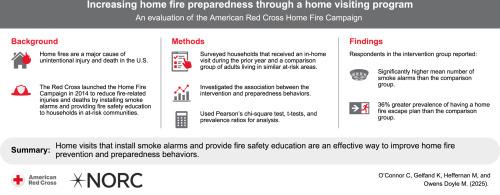Increasing home fire preparedness through a home visiting program: an evaluation of the American Red Cross Home Fire Campaign
IF 4.5
1区 地球科学
Q1 GEOSCIENCES, MULTIDISCIPLINARY
International journal of disaster risk reduction
Pub Date : 2025-09-03
DOI:10.1016/j.ijdrr.2025.105802
引用次数: 0
Abstract
Home fires are a major cause of unintentional injury and death in the U.S. In 2023, home fires caused nearly 3000 deaths. Smoke alarms and home fire escape plans are recommended to prevent home fires and prepare households to evacuate in the event of a fire. In 2014, the Red Cross launched the Home Fire Campaign to reduce fire-related injuries and deaths by installing smoke alarms and providing fire safety education to households in at-risk communities, documenting 2420 lives saved since its inception. To evaluate the program, in 2023, we surveyed households that received an Home Fire Campaign visit during the prior year and a comparison group of adults living in similar at-risk areas. We investigated the association between the intervention and preparedness behaviors using two outcomes: number of smoke alarms in homes and presence of home fire escape plans. We used Pearson's chi-square test for significance between the intervention and outcomes, conducted t-tests for the mean number of smoke alarms between groups, and calculated prevalence ratios for the presence of home fire escape plans. The intervention was positively associated with both outcomes. Respondents in the intervention group reported a significantly higher mean number of smoke alarms and a 36 % greater prevalence of having a home fire escape plan than the comparison group. Associations were strongest among adults 65 and older for smoke alarms and adults younger than 45 for escape plans. Findings suggest home visits are an effective way to improve home fire prevention and preparedness behaviors.

通过家访计划增加家庭火灾准备:对美国红十字会家庭火灾运动的评估
在美国,家庭火灾是造成意外伤害和死亡的主要原因。2023年,家庭火灾造成近3000人死亡。建议使用烟雾报警器和家庭火灾逃生计划来防止家庭火灾,并为家庭在火灾发生时撤离做好准备。2014年,红十字会发起了家庭火灾运动,通过安装烟雾报警器和向危险社区的家庭提供消防安全教育,减少与火灾有关的伤害和死亡,记录了自该运动启动以来挽救的2420人的生命。为了评估该计划,我们在2023年调查了上一年接受过家庭火灾活动访问的家庭,以及一组生活在类似危险地区的成年人。我们使用两个结果调查了干预和准备行为之间的关系:家庭中烟雾报警器的数量和家庭火灾逃生计划的存在。我们使用皮尔逊卡方检验来检验干预措施和结果之间的显著性,对组间烟雾报警器的平均数量进行t检验,并计算家庭火灾逃生计划存在的患病率。干预与两种结果呈正相关。干预组的受访者报告说,烟雾报警器的平均数量明显高于对照组,家庭火灾逃生计划的普及率比对照组高36%。65岁及以上的成年人对烟雾报警器和45岁以下的成年人对逃生计划的相关性最强。研究结果表明,家访是改善家庭火灾预防和准备行为的有效途径。
本文章由计算机程序翻译,如有差异,请以英文原文为准。
求助全文
约1分钟内获得全文
求助全文
来源期刊

International journal of disaster risk reduction
GEOSCIENCES, MULTIDISCIPLINARYMETEOROLOGY-METEOROLOGY & ATMOSPHERIC SCIENCES
CiteScore
8.70
自引率
18.00%
发文量
688
审稿时长
79 days
期刊介绍:
The International Journal of Disaster Risk Reduction (IJDRR) is the journal for researchers, policymakers and practitioners across diverse disciplines: earth sciences and their implications; environmental sciences; engineering; urban studies; geography; and the social sciences. IJDRR publishes fundamental and applied research, critical reviews, policy papers and case studies with a particular focus on multi-disciplinary research that aims to reduce the impact of natural, technological, social and intentional disasters. IJDRR stimulates exchange of ideas and knowledge transfer on disaster research, mitigation, adaptation, prevention and risk reduction at all geographical scales: local, national and international.
Key topics:-
-multifaceted disaster and cascading disasters
-the development of disaster risk reduction strategies and techniques
-discussion and development of effective warning and educational systems for risk management at all levels
-disasters associated with climate change
-vulnerability analysis and vulnerability trends
-emerging risks
-resilience against disasters.
The journal particularly encourages papers that approach risk from a multi-disciplinary perspective.
 求助内容:
求助内容: 应助结果提醒方式:
应助结果提醒方式:


